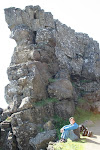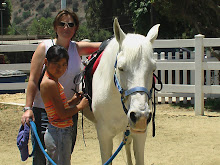August 12, 2009
Equine Clicker Training with Pat Lincourt: part one
Patricia Lincourt is an extraordinary horse trainer and riding instructor working in the Los Angeles area. Patricia owns and runs Lincourt Stables, a traditional hunter jumper barn at The Paddock Riding Club on Rigali Avenue. Ms. Lincourt has a lifetime of experience with horses and has trained and taught riding for many years. In addition to helping her students and horses to become the best show jumpers that they can be, Patricia has recently added a new method to her training repertoire and is using it to great advantage with a few of the horses under her tutelage: clicker training.
The use of clicker training with horses is a relatively recent event in the horse world, but it is becoming an increasingly widespread and popular training tool. Many professional horse trainers as well as amateur horse owners have discovered that clicker training can produce some amazing results, if used correctly and consistently over a period of time. First developed by zoo keepers and handlers of marine mammals in wild animal parks, clicker training involves using a small hand-held clicker to make a defined and unique sound that is recognized by the animal as a marker of a specific behavior.
By clicking the instant the animal performs what it is being asked, the trainer can reinforce that behavior and then reward the animal with food, treats or play. Using the snapping noise of a clicker is more consistent and less confusing than vocal signals or voice commands because it doesn’t sound like anything else and isn’t used or overheard at any other time. To get an idea of what a clicker sounds like, think of a Purim grogger or that small metal toy that makes a cricket-like sound when pushed. Some clicker training involves a long pole with a soft rubber or foam ball at the end, called a target. The animal is asked to approach and touch the target with its mouth or flipper, in order to get a food treat or reward.
Clicker training to a target was developed to enable handlers and veterinarians to get close to and examine large animals such as dolphins, sea lions and killer whales, and encourage the animals to allow themselves to be touched and handled. Getting close to a large, powerful animal that spends most of its time in the water is a tricky but essential part of caring for marine mammals. Clicker training also provides mental and physical stimulation to highly intelligent and energetic animals in captivity. If you’ve ever seen a show at Sea World with a leaping dolphin or splashing killer whale doing tricks on cue for the trainer, it’s a good bet that clicker training was involved.
When she was given a very difficult horse to work with and discovered that conventional training methods were not doing the trick, Pat turned to clicker training. No amount of groundwork or gentling could convince Buddy, a six year old paint horse, to allow anyone to ride him or even get on his back without bucking them off. Cowboy-style techniques that tried to “break” the horse failed miserably. Even Parelli’s methods of using groundwork to join up with and gain the horse’s trust did not succeed, once a rider tried to get near Buddy’s back or into the saddle. Buddy’s owner was about to give up all hope and send the young horse out to pasture, when she asked Pat to give it one last try.
Lincourt decided to try clicker training when she found herself with a horse that did not respond to conventional training methods. Pat had heard about clicker training from a book by Shawna Karrasch, “You Can Train Your Horse to Do Anything.” Shawna had worked at Sea World as a marine mammal trainer for many years when she became interested in the possibilities of applying clicker techniques to horse training. No longer at Sea World, Shawna has worked as a horse trainer for professional show jumpers since 1995 and is the owner of and co-founder of "On Target Training." [Note: Shawna Karrasch's website can be found at http://www.on-target-training.com/]
Pat decided to teach herself how to clicker train using Shawna’s book and instructional video, hoping that she could turn Buddy around. She began training with the usual tools, a clicker and a target pole and food treats. Buddy turned out to be particularly challenging to train because he turned up his nose at all the usual horse treats. He hated carrots and scoffed at most other foods that were offered to him. With persistence and patience, Pat finally hit upon his motivation: anything with molasses! Armed with molasses-infused treats, she set out to gain the horse’s trust and try to calm down his fear and deeply-ingrained bucking behavior.
“Clicker training is not a quick fix,” Pat cautions. “It won’t work unless you take your time, move slowly and incrementally and do it with consistency.” She notes that her hunter-jumper students are not particularly interested in learning clicker training because of its slow progress and need for patience and absolute consistency of method. Buddy was not a complete success in Pat’s opinion because he didn’t become a completely calm and dependable riding horse. But he was able to allow her to get on him and learned not to buck her off.
Although she feels that she just didn’t have enough time to complete Buddy’s training before the owner decided to sell him, she does think his prospects were improved. Buddy became a much more trusting and less volatile horse, and given more time with him, Pat believes that he would have been a good prospect for pulling a cart or working as part of a team of horses that pull a stagecoach or wagon. It’s clear that he didn’t have much of a chance at all until Pat gave him her time and attention, and used clicker training to get his mind focused and calm, helping him to overcome fear and bad habits. Buddy was sold, though not as a riding horse, and was given a new lease on life, thanks to Pat.
To be continued....
The use of clicker training with horses is a relatively recent event in the horse world, but it is becoming an increasingly widespread and popular training tool. Many professional horse trainers as well as amateur horse owners have discovered that clicker training can produce some amazing results, if used correctly and consistently over a period of time. First developed by zoo keepers and handlers of marine mammals in wild animal parks, clicker training involves using a small hand-held clicker to make a defined and unique sound that is recognized by the animal as a marker of a specific behavior.
By clicking the instant the animal performs what it is being asked, the trainer can reinforce that behavior and then reward the animal with food, treats or play. Using the snapping noise of a clicker is more consistent and less confusing than vocal signals or voice commands because it doesn’t sound like anything else and isn’t used or overheard at any other time. To get an idea of what a clicker sounds like, think of a Purim grogger or that small metal toy that makes a cricket-like sound when pushed. Some clicker training involves a long pole with a soft rubber or foam ball at the end, called a target. The animal is asked to approach and touch the target with its mouth or flipper, in order to get a food treat or reward.
Clicker training to a target was developed to enable handlers and veterinarians to get close to and examine large animals such as dolphins, sea lions and killer whales, and encourage the animals to allow themselves to be touched and handled. Getting close to a large, powerful animal that spends most of its time in the water is a tricky but essential part of caring for marine mammals. Clicker training also provides mental and physical stimulation to highly intelligent and energetic animals in captivity. If you’ve ever seen a show at Sea World with a leaping dolphin or splashing killer whale doing tricks on cue for the trainer, it’s a good bet that clicker training was involved.
When she was given a very difficult horse to work with and discovered that conventional training methods were not doing the trick, Pat turned to clicker training. No amount of groundwork or gentling could convince Buddy, a six year old paint horse, to allow anyone to ride him or even get on his back without bucking them off. Cowboy-style techniques that tried to “break” the horse failed miserably. Even Parelli’s methods of using groundwork to join up with and gain the horse’s trust did not succeed, once a rider tried to get near Buddy’s back or into the saddle. Buddy’s owner was about to give up all hope and send the young horse out to pasture, when she asked Pat to give it one last try.
Lincourt decided to try clicker training when she found herself with a horse that did not respond to conventional training methods. Pat had heard about clicker training from a book by Shawna Karrasch, “You Can Train Your Horse to Do Anything.” Shawna had worked at Sea World as a marine mammal trainer for many years when she became interested in the possibilities of applying clicker techniques to horse training. No longer at Sea World, Shawna has worked as a horse trainer for professional show jumpers since 1995 and is the owner of and co-founder of "On Target Training." [Note: Shawna Karrasch's website can be found at http://www.on-target-training.com/]
Pat decided to teach herself how to clicker train using Shawna’s book and instructional video, hoping that she could turn Buddy around. She began training with the usual tools, a clicker and a target pole and food treats. Buddy turned out to be particularly challenging to train because he turned up his nose at all the usual horse treats. He hated carrots and scoffed at most other foods that were offered to him. With persistence and patience, Pat finally hit upon his motivation: anything with molasses! Armed with molasses-infused treats, she set out to gain the horse’s trust and try to calm down his fear and deeply-ingrained bucking behavior.
“Clicker training is not a quick fix,” Pat cautions. “It won’t work unless you take your time, move slowly and incrementally and do it with consistency.” She notes that her hunter-jumper students are not particularly interested in learning clicker training because of its slow progress and need for patience and absolute consistency of method. Buddy was not a complete success in Pat’s opinion because he didn’t become a completely calm and dependable riding horse. But he was able to allow her to get on him and learned not to buck her off.
Although she feels that she just didn’t have enough time to complete Buddy’s training before the owner decided to sell him, she does think his prospects were improved. Buddy became a much more trusting and less volatile horse, and given more time with him, Pat believes that he would have been a good prospect for pulling a cart or working as part of a team of horses that pull a stagecoach or wagon. It’s clear that he didn’t have much of a chance at all until Pat gave him her time and attention, and used clicker training to get his mind focused and calm, helping him to overcome fear and bad habits. Buddy was sold, though not as a riding horse, and was given a new lease on life, thanks to Pat.
To be continued....
Subscribe to:
Post Comments (Atom)
.jpg)







No comments:
Post a Comment